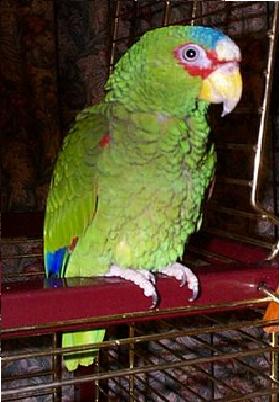Amazon - White Fronted
Spectacled Amazon Scientific Name: Amazona albifrons albifrons
Sun, 13th July, 2025 - 7:28 am GMT
Sponsor Ads:

Alternative Name
Spectacled Amazon Scientific Name: Amazona albifrons albifronsBasic Info
Though the White Fronted Amazon is of average size, when compared to other parrots, it is relatively small when compared to other Amazons. At maturity this species will grow to an average length of only nine to ten inches in length. This species is named for the bright white patch of feathers, which is seen on their foreheads. The amount of white seems to vary from individual to individual. They have green plumage throughout and red cheeks. This species is similar to the Red Lored Amazon in appearance, but the Red Lored has a red forehead, and yellow cheeks. Males and females can be distinguished by appearance. The males have bright red feathers on their shoulders and the females have green shoulders. In addition to the nominate species of White fronted Amazon (Amazona albifrons albifrons) there are two other known subspecies and these include the Lesser White Fronted Amazon (Amazona albifrons nana) and the Sonora White Fronted Amazon (Amazona albifrons saltuensis). All three subspecies are very similar in appearance, though slight color differences exist between the subspecies.
Health
Most Amazons enjoy regular bathing, and the White Front is no different. They should be given access to baths regularly, or misted frequently. It is important that they are not allowed to get too cold when showering, and for this reason it is advised to give baths in warm rooms during the daytime. Like other Amazons, the White Fronted Amazon is prone to obesity. For this reason they should not be given excessively fatty seeds such as sunflower and safflower seeds. Seeds should really only be given as a treat because they have such a large propensity towards obesity. With this in mind, they do well on a varied diet that can consist of formulated pellets, vegetables and fruits. This species may not eat well in captivity if it is overly stressed. It is important to monitor their eating under stressful situations. Like many large parrots the White Fronted Amazon is susceptible to Psittacosis and bacterial infections. Another common cause of death in Amazons is accidental poisoning, such as lead poisoning. For this reason it is important to supervise your White Fronted Amazon when it is allowed out of its cage. Breeding Although Amazons in general are relatively difficult to breed in captivity, the White Fronted Amazon is bred regularly. Their breeding season is usually in the spring, starting in February and ending in the summer (between June and July in most areas). After breeding the female will lay an average of three to four eggs. Eggs incubate for 24 to 26 days and babies fledge anywhere from 10 to 12 weeks of age. Babies are usually not difficult to hand raise, and this is often preferred if babies are to be sold as pets. A problem when breeding White Fronts is that males will often become aggressive towards females during breeding season. For this reason a pair must be watched, and separated if the male is overly aggressive. This species may also become aggressive to their owners during breeding season.Habitat
They are seen in a variety of different habitats from wet regions such as rain forests, to drier areas such as cactus savannahs.Behavior
The White Fronted Amazon is known for its attractive plumage and its excellent talking ability. The White Fronted Amazon is not as popular in captivity as some other Amazon species, but it is seen in the pet trade and is known as an intelligent bird. While some White Fronted Amazons never learn to speak, others become very adept at it. One should never purchase a parrot solely for speaking, since even breeds that are known as the best talkers (African Grays are an example) will have members that never speak and only emit an occasional whistle. The White Fronted Amazon enjoys chewing, and for this reason it should be provided plenty of toys and branches. Because of its intelligence, this species can, and will become bored without toys, so they are a must. Additionally unwanted behavior such as feather plucking may result if they are not stimulated. The White Fronted Amazon is very curious about its environment, though it may be shyer than many other popular parrot species. This species should be well socialized to new people and new situations at an early age to prevent unhealthy fear later in life. If this species is not well socialized they may experience extreme fear over new people, toys and other novel stimulus. It should be noted that like most Amazons, the White Fronted Amazon can be very noisy, and for this reason they may not be well suited to apartment life. Additionally they can be quite messy, like all large parrots. These facts should be carefully considered before purchase.Origin
Central America and MexicoHistory
The White Fronted Amazon is native to Central America and Southern Mexico; and is most often seen in small groups of up to 20 birds. In the wild, they are not shy and people are often able to approach them. Flocks may congregate and people have seen groups that number into the hundreds. These groups may also contain flocks from other species such as the Red Lored Parrot.Common Foods
N/ASponsor Ads:
The race is not always to the swift, nor the battle to the strong, but that's the way to bet 'em. -- Unknown
Amazon - White Fronted
Coded by: BGID® | ALL RIGHTS RESERVED Copyright © 2000-2025
Disclaimer | Privacy | Report Errors / Contact | Credits
















